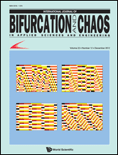
INTERNATIONAL JOURNAL OF BIFURCATION AND CHAOS
Scope & Guideline
Pioneering Interdisciplinary Studies in Complexity Science
Introduction
Aims and Scopes
- Bifurcation Theory:
The journal extensively covers studies on bifurcation phenomena, including local and global bifurcations in various mathematical models, focusing on their implications in real-world systems. - Chaos Theory:
Research on chaotic systems, including the analysis of chaotic dynamics, stability, and the characterization of chaotic attractors, is a core area of focus. - Mathematical Modeling:
The journal emphasizes the development and analysis of mathematical models that describe complex dynamical systems across disciplines such as biology, engineering, and economics. - Interdisciplinary Applications:
Papers often explore the applications of bifurcation and chaos theories in various fields, demonstrating their relevance in understanding phenomena like epidemic dynamics, ecological interactions, and electrical circuits. - Computational Methods:
The use of computational techniques for simulating dynamical systems and visualizing bifurcations and chaos is a recurring theme, supporting theoretical findings with numerical evidence.
Trending and Emerging
- Complex Systems and Networks:
There is an increasing trend towards studying complex systems and networks, particularly in understanding their bifurcations and chaotic behavior, reflecting the interconnectedness of modern scientific inquiries. - Fractional Dynamics:
Research on fractional-order systems and their dynamics is gaining momentum, highlighting the importance of memory and hereditary properties in various applications, such as control systems and biological models. - Real-Time Data Integration:
The integration of real-time data into mathematical models is emerging as a significant trend, emphasizing the need for adaptive models that can respond to dynamic changes in real-world scenarios. - Multiscale Modeling:
Papers that explore multiscale modeling techniques are on the rise, addressing the complexities of systems that operate across different spatial and temporal scales. - Applications in Machine Learning and AI:
The intersection of chaos theory and machine learning is becoming increasingly prominent, with studies focusing on using chaotic systems for data encryption, pattern recognition, and neural network training.
Declining or Waning
- Deterministic Chaos in Simple Systems:
Research focusing on deterministic chaos in relatively simple or classical systems has seen a decline, possibly due to a shift towards more complex and realistic models that incorporate various factors. - Static Mathematical Models:
Papers that rely on static models without considering dynamic interactions or real-time data analysis are becoming less common, as the field moves towards more adaptive and responsive modeling techniques. - Single-Domain Studies:
Research that focuses solely on one domain, such as purely mathematical explorations without interdisciplinary connections, is waning, as there is a growing emphasis on applications across multiple fields. - Basic Bifurcation Analysis:
The foundational studies on bifurcations that do not incorporate advanced computational simulations or real-world applications are appearing less frequently, as researchers seek to integrate more complex analyses. - Linear Systems Analysis:
The analysis of linear systems and their bifurcations is becoming less prominent, as the focus shifts towards nonlinear dynamics and their intricate behaviors in various applications.
Similar Journals

DISCRETE AND CONTINUOUS DYNAMICAL SYSTEMS-SERIES B
Advancing Knowledge in Discrete and Continuous SystemsDISCRETE AND CONTINUOUS DYNAMICAL SYSTEMS-SERIES B, published by the American Institute of Mathematical Sciences (AIMS), is a premier journal in the fields of Applied Mathematics and Discrete Mathematics and Combinatorics. With an ISSN of 1531-3492 and an E-ISSN of 1553-524X, the journal addresses significant advances in the mathematical sciences, particularly focusing on the analysis of dynamical systems through discrete and continuous approaches. As recognized in the 2023 Scopus ranks, it holds a commendable position, being classified in the Q2 category for both its mathematical domains, reflecting its high-quality publications and substantial impact on ongoing research. With a converged publication timeline from 2001 to 2025, the journal plays an essential role in facilitating innovative mathematical discourse, making it an invaluable resource for researchers, professionals, and students eager to explore the latest developments and applications in this dynamic field. Although specific open access options are not currently stated, the journal remains committed to disseminating valuable content for those passionate about the intricacies of mathematical systems.

NONLINEAR DYNAMICS
Pioneering Research in Diverse Engineering FieldsNONLINEAR DYNAMICS is an esteemed academic journal published by SPRINGER, focusing on a diverse range of topics within the fields of Aerospace Engineering, Applied Mathematics, Control and Systems Engineering, Electrical and Electronic Engineering, Mechanical Engineering, and Ocean Engineering. Since its inception in 1990, this journal has become a premier platform for disseminating cutting-edge research and innovative methodologies from both theoretical and practical perspectives. With a high impact factor and ranked in the Q1 quartile across several engineering and mathematics categories, NONLINEAR DYNAMICS is recognized for its significant contribution to advancing knowledge and technology in nonlinear phenomena. Researchers and professionals are encouraged to engage with this journal to publish their findings and stay at the forefront of developments. Although it does not offer open access options, the journal ensures rigorous peer review, enhancing the credibility and visibility of published work.
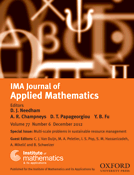
IMA JOURNAL OF APPLIED MATHEMATICS
Pioneering Research for a Mathematical TomorrowThe IMA Journal of Applied Mathematics, published by Oxford University Press, serves as a pivotal platform for disseminating innovative research in the field of applied mathematics. With its ISSN 0272-4960 and E-ISSN 1464-3634, the journal has established itself as an essential resource for academics and practitioners, showing notable engagement with both theoretical and practical aspects of mathematics. Spanning over five decades since its inception in 1965, the journal covers a broad range of topics aimed at addressing complex real-world problems through mathematical modeling and computational techniques. Holding a Q3 quartile ranking in the applied mathematics category for 2023, and a Scopus rank of #310 out of 635, it plays a significant role in contributing to the academic discourse within this dynamic field. Despite not being open access, the journal's robust reputation and commitment to rigorous peer review ensure that cutting-edge research remains accessible to its audience of researchers, professionals, and students dedicated to advancing mathematical sciences. Its ongoing commitment to exceptional scholarship makes the IMA Journal of Applied Mathematics a vital resource for those seeking to explore and apply mathematical principles in various contexts.
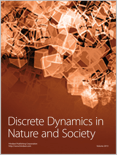
DISCRETE DYNAMICS IN NATURE AND SOCIETY
Transforming Understanding of Natural and Societal Phenomena through Discrete InsightsDISCRETE DYNAMICS IN NATURE AND SOCIETY is a leading academic journal published by HINDAWI LTD, specializing in the intricate interrelationship between discrete modeling and its applications in both natural phenomena and societal dynamics. Established as an Open Access journal since 1997, it ensures that research outputs are freely accessible to a global audience, fostering collaboration and innovation within the field. Based in the United States, this journal has seen substantial contributions to the domains of mathematics, modeling, and simulation, achieving a commendable Q3 category ranking for its impact in these areas. With its robust focus on empirical research and the theoretical underpinnings of discrete systems, the journal appeals to a diverse readership including researchers, professionals, and students eager to explore and contribute to the ongoing discussions shaping our understanding of dynamics in complex systems.

JOURNAL OF DYNAMICAL AND CONTROL SYSTEMS
Connecting Researchers to Transformative Knowledge in Control SystemsJOURNAL OF DYNAMICAL AND CONTROL SYSTEMS is a premier interdisciplinary journal published by Springer/Plenum Publishers, recognized for its significant contributions to the fields of dynamical systems, control theory, and numerical analysis. With an ISSN of 1079-2724 and an E-ISSN of 1573-8698, the journal serves as an important platform for researchers and professionals to share their findings and innovative methodologies. Covering topics from algebra and number theory to control and optimization, it holds a respectable position in the 2023 Q2 quartile rankings across various categories, reflecting its impact and quality within the academic community. The journal’s scope is expansive, aiming to foster advancements and insights that are instrumental for academics and industry experts alike. With a convergence period from 1995 to 2024, the journal continues to be a vital resource for students, researchers, and professionals seeking to navigate the complexities of control systems and their dynamic interactions. For those looking to contribute to the ongoing discourse in these critical areas of study, the JOURNAL OF DYNAMICAL AND CONTROL SYSTEMS remains a highly recommended choice.
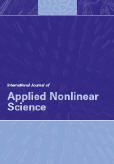
International Journal of Applied Nonlinear Science
Unraveling Complexity: The Intersection of Theory and ApplicationInternational Journal of Applied Nonlinear Science, published by INDERSCIENCE ENTERPRISES LTD, is a leading platform dedicated to the dissemination of innovative research in the field of nonlinear science. With an emphasis on applied methodologies, this journal focuses on the practical implementations of nonlinear theories across various disciplines, including engineering, physics, and applied mathematics. Contributions to the journal foster interdisciplinary dialogue, encouraging the exploration of complex systems and their behaviors. Although currently not an open-access publication, its accessibility through institutional subscriptions ensures that essential research reaches a wide audience. The journal seeks to provide a forum for the exchange of ideas and advancements that push the boundaries of conventional science, thereby appealing to researchers, professionals, and students alike who are eager to engage with cutting-edge developments in nonlinear science.

Differential Equations and Dynamical Systems
Unraveling Complexities through Differential EquationsDifferential Equations and Dynamical Systems is a prominent academic journal published by Springer India, dedicated to the fields of analysis and applied mathematics. With an ISSN of 0971-3514 and an E-ISSN of 0974-6870, this journal serves as a platform for scholars to disseminate innovative research on differential equations and their applications in various dynamical systems. Recognized within the Q3 category for both Analysis and Applied Mathematics, it ranks impressively in Scopus, highlighting its contribution to the advancement of mathematical sciences. The journal aims to foster interdisciplinary research and provide an inclusive forum for researchers, professionals, and students engaged in this vital area of study. Although not open access, it offers valuable insights and findings published from 2008 to 2024, reinforcing its importance as a resource for ongoing developments in mathematical analysis. As a reputable source in its field, it invites contributions that challenge existing paradigms and inspire further inquiry.
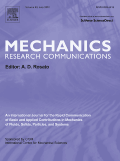
MECHANICS RESEARCH COMMUNICATIONS
Transforming Ideas into Engineering BreakthroughsMECHANICS RESEARCH COMMUNICATIONS, published by PERGAMON-ELSEVIER SCIENCE LTD, is a prestigious journal in the fields of Civil and Structural Engineering, Condensed Matter Physics, Materials Science, and Mechanical Engineering. With an ISSN of 0093-6413 and E-ISSN of 1873-3972, it has made significant contributions to the understanding and advancement of mechanics and materials since its inception in 1974. The journal is well-regarded in academia, holding a Q2 ranking across multiple categories as of 2023, and ranking in the 65th percentile for Mechanical Engineering. Researchers and professionals benefit from its peer-reviewed content, which includes a wide range of articles from fundamental research to applied technological developments. Although currently not an open access journal, it remains a vital resource for those focused on innovating within the engineering and materials science domains. With its established legacy, MECHANICS RESEARCH COMMUNICATIONS continues to shape the discourse in mechanics and engineering, making it essential reading for students and practitioners alike.
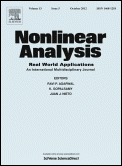
NONLINEAR ANALYSIS-REAL WORLD APPLICATIONS
Unlocking Potential in Nonlinear ApplicationsNONLINEAR ANALYSIS-REAL WORLD APPLICATIONS, published by PERGAMON-ELSEVIER SCIENCE LTD, is a premier academic journal dedicated to advancing the field of nonlinear analysis through rigorous research and practical applications. With an impressive impact factor and categorized in the Q1 quartile across multiple disciplines including applied mathematics, computational mathematics, and engineering, this journal stands as a vital resource for researchers, professionals, and students. Its extensive scope encompasses significant contributions from the domains of economics, medicine, and various engineering fields, making it a leading platform for interdisciplinary exchange. The journal's commitment to showcasing innovative methodologies and solutions from 2000 to 2025 not only enhances its academic prestige but also fosters real-world impact, thus catering to a diverse scholarly audience eager to explore the complexities and potentials of nonlinear phenomena. Access options vary, ensuring a wide dissemination of knowledge to drive future discoveries in this dynamic area of study.

Journal of Dynamical Systems and Geometric Theories
Transforming Knowledge in Dynamical SystemsJournal of Dynamical Systems and Geometric Theories, published by TARU Publications, is a prominent platform dedicated to advancing knowledge in the fields of dynamical systems and geometric theories. With an ISSN of 1726-037X and an E-ISSN of 2169-0057, this journal serves as a vital resource for researchers, professionals, and students who are keen on exploring the complexities of mathematical models and their applications in various scientific disciplines. Though currently listed as non-open access, the journal provides robust, peer-reviewed content that is essential for fostering innovative research and development. Situated in New Delhi, India, the Journal of Dynamical Systems and Geometric Theories is committed to disseminating high-quality scholarly articles that address both theoretical and practical issues related to dynamical systems, enhancing understanding and stimulating further academic discourse. To learn more about submission guidelines and access options, please visit the journal’s official webpage.